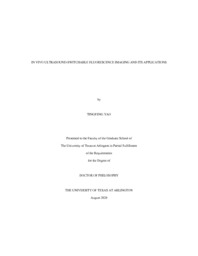
ATTENTION: The works hosted here are being migrated to a new repository that will consolidate resources, improve discoverability, and better show UTA's research impact on the global community. We will update authors as the migration progresses. Please see MavMatrix for more information.
Show simple item record
| dc.contributor.advisor | Yuan, Baohong | |
| dc.creator | Yao, Tingfeng | |
| dc.date.accessioned | 2022-08-24T15:15:34Z | |
| dc.date.available | 2022-08-24T15:15:34Z | |
| dc.date.created | 2020-08 | |
| dc.date.issued | 2020-08-17 | |
| dc.date.submitted | August 2020 | |
| dc.identifier.uri | http://hdl.handle.net/10106/30871 | |
| dc.description.abstract | The conventional fluorescence imaging has limited spatial resolution in centimeters-deep tissue because of the tissue’s high scattering property. Ultrasound-switchable fluorescence (USF) imaging, a new imaging technique, was recently proposed to realize high-resolution fluorescence imaging in centimeters-deep tissue. Although promising results were achieved in tissue-mimic phantoms or tissue samples, the in vivo USF imaging had not been realized so far. There were two major challenges in realizing in vivo USF imaging. First, the lack of stable near-infrared (NIR) USF contrast agents in a biological environment and the lack of data about their biodistributions. Second, the previous USF imaging systems adopted a fiber bundle to collect the emitted fluorescence photons, which led to a few limitations, such as (1) low photon-collection efficiency; (2) low efficiency for scanning a sample with an uneven surface (such as a mouse); (3) low imaging speed, because of the adoption of a raster scan and the long wait time for the tissue to cool down before starting the data acquisition at the next location. This work focuses on two parts: (1) investigating the biodistribution of the NIR USF contrast agents in mice and demonstrating their feasibility of in vivo USF imaging; (2) developing camera-based USF imaging systems and a faster scan method.
First, the biodistribution of the Indocyanine green (ICG)-encapsulated poly(N-isopropylacrylamide) (PNIPAM) nanoparticle (ICG-PNIPAM NP) in mice was studied. The ICG-PNIPAM NP (with an average diameter of ~335 nm) was mainly accumulated into the spleen of the mice. In vivo and ex vivo USF imaging of the mouse spleen via intravenous injections using frequency-domain USF imaging system were successfully achieved. The accuracy of the USF imaging was validated by a commercial micro-CT system. Second, an electron-multiplying charge-coupled device (EMCCD) camera-based USF imaging system was proposed to overcome the limitations of the previous fiber bundle-based USF imaging systems. Thanks to the spatial information provided by the camera, a new scan method, Z-scan, was developed, and the imaging speed was improved four times over the raster scan. Third, the biodistribution of β-cyclodextrin/ICG complex-encapsulated PNIPAM nanogel (PNIPAM/β‐CD/ICG nanogel) in mice was investigated. The PNIPAM/β‐CD/ICG nanogel (with an average diameter of ~32 nm) could quickly accumulate into the liver tissue and then degrade fast in a short period. Animal experiments also showed that the present nanogels were able to be effectively accumulated into U87 tumor of a live mouse via the enhanced permeability and retention effect. The ex vivo USF imaging of the mouse liver and in vivo USF imaging in mouse tumor using the EMCCD camera-based USF imaging system were successfully obtained. Fourth, an improved EMCCD camera-based USF imaging system via a software trigger mode was proposed. The USF imaging of a sub-millimeter silicone tube with an inner diameter of 0.76 mm and an outer diameter of 1.65 mm in 5.5 cm-thick chicken breast tissue using 808 nm excitation light with a low intensity of 28.35 mW/cm2 was successfully achieved.
In summary, the results provided in this work demonstrated for the first time the feasibility of USF imaging in living mice. Both ICG-PNIPAM NP and PNIPAM/β‐CD/ICG nanogel showed great stability in a biological environment. Their biodistributions were different due to the various sizes. Camera-based USF imaging systems could improve the photon collection efficiency and increase the imaging speed by adopting a Z-scan method. The USF imaging of submillimeter objects in centimeters-deep tissue could be achieved by optimizing the gain of the EMCCD camera. This work has paved the way for adopting USF imaging technique in many potential biomedical applications in future. | |
| dc.format.mimetype | application/pdf | |
| dc.language.iso | en_US | |
| dc.subject | ultrasound-switchable fluorescence, in vivo imaging, deep tissue fluorescence imaging | |
| dc.title | In vivo ultrasound-switchable fluorescence imaging and its applications | |
| dc.type | Thesis | |
| dc.degree.department | Bioengineering | |
| dc.degree.name | Doctor of Philosophy in Biomedical Engineering | |
| dc.date.updated | 2022-08-24T15:15:34Z | |
| thesis.degree.department | Bioengineering | |
| thesis.degree.grantor | The University of Texas at Arlington | |
| thesis.degree.level | Doctoral | |
| thesis.degree.name | Doctor of Philosophy in Biomedical Engineering | |
| dc.type.material | text | |
| dc.creator.orcid | 0000-0001-8077-0643 | |
Files in this item
- Name:
- YAO-DISSERTATION-2020.pdf
- Size:
- 29.74Mb
- Format:
- PDF
This item appears in the following Collection(s)
Show simple item record


